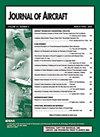Multidisciplinary Design Optimization of Transonic Wings with Boundary-Layer Suction
IF 2.1
3区 工程技术
Q2 ENGINEERING, AEROSPACE
引用次数: 0
Abstract
A quasi-three-dimensional aerodynamic solver is developed for the aerodynamic analysis of wings in a transonic regime that is able to capture the effect of BLS in hybrid laminar flow control (HLFC) application or transition to turbulent flow for natural laminar flow (NLF). The tool provides accurate results, but without the high computational cost of high-fidelity tools. The solver combines the use of an Euler flow solver characterized by an integral boundary-layer method and linear stability analysis using a [Formula: see text] approximation for transition prediction. In particular, a conical transformation is adopted, including the determination of the shock-wave position. The solver is implemented in a multidisciplinary design optimization (MDO) framework, including wing weight estimation and aircraft performance analysis. The framework consists of different modules: aerodynamics, structure, suction system analysis, and performance evaluation. Using a genetic algorithm and considering HLFC technology, wing MDO has been performed to find the optimum wing planform and airfoil shape. A backward-swept wing (BSW) aircraft, developed inside the Cluster of Excellence–Sustainable and Energy Efficient Aviation ([Formula: see text]A) is studied. Novel technologies such as active flow control, limited maximum load factors due to load alleviation, and novel materials allow a fuel weight reduction of 6%.边界层吸力跨声速机翼多学科设计优化
针对机翼跨声速气动分析,开发了一种准三维气动求解器,能够捕捉BLS在混合层流控制(HLFC)应用或自然层流(NLF)向湍流过渡时的影响。该工具提供准确的结果,但没有高保真工具的高计算成本。该求解器结合了欧拉流动求解器的使用,其特征是积分边界层法和线性稳定性分析,使用[公式:见文本]近似进行过渡预测。特别采用了锥形变换,包括激波位置的确定。求解器在多学科设计优化(MDO)框架下实现,包括翼重估算和飞机性能分析。该框架由不同的模块组成:空气动力学、结构、吸力系统分析和性能评估。采用遗传算法并考虑HLFC技术,对机翼进行了MDO求解,得到了最优的机翼平台和翼型形状。研究了一种后掠翼(BSW)飞机,该飞机是在卓越集群-可持续和节能航空([公式:见文本]A)内开发的。新技术,如主动流量控制,由于负载减轻而限制的最大负载系数,以及新材料,使燃料重量减少了6%。
本文章由计算机程序翻译,如有差异,请以英文原文为准。
求助全文
约1分钟内获得全文
求助全文
来源期刊

Journal of Aircraft
工程技术-工程:宇航
CiteScore
4.50
自引率
31.80%
发文量
141
审稿时长
6 months
期刊介绍:
This Journal is devoted to the advancement of the applied science and technology of airborne flight through the dissemination of original archival papers describing significant advances in aircraft, the operation of aircraft, and applications of aircraft technology to other fields. The Journal publishes qualified papers on aircraft systems, air transportation, air traffic management, and multidisciplinary design optimization of aircraft, flight mechanics, flight and ground testing, applied computational fluid dynamics, flight safety, weather and noise hazards, human factors, airport design, airline operations, application of computers to aircraft including artificial intelligence/expert systems, production methods, engineering economic analyses, affordability, reliability, maintainability, and logistics support, integration of propulsion and control systems into aircraft design and operations, aircraft aerodynamics (including unsteady aerodynamics), structural design/dynamics , aeroelasticity, and aeroacoustics. It publishes papers on general aviation, military and civilian aircraft, UAV, STOL and V/STOL, subsonic, supersonic, transonic, and hypersonic aircraft. Papers are sought which comprehensively survey results of recent technical work with emphasis on aircraft technology application.
 求助内容:
求助内容: 应助结果提醒方式:
应助结果提醒方式:


